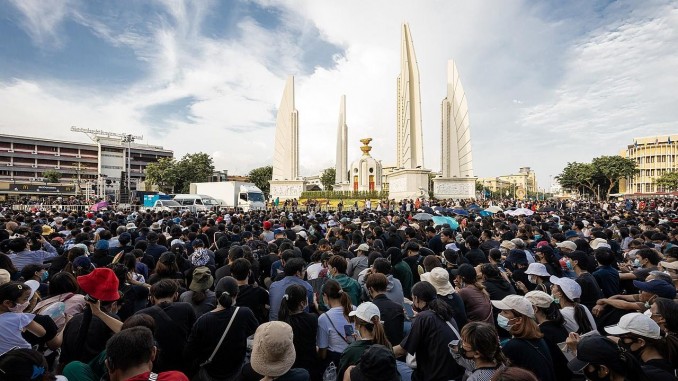
Translated from an article in Convergences Revolutionaires, published by L’Etincelle, October 22, 2020
In recent weeks, demonstrations by Thai youth against Prime Minister Prayuth Chan-o-cha and the outdated institution of the monarchy have resumed at an unprecedented scale. Almost daily, tens of thousands of university and high school students take to the streets, despite the intensification of repression by the government since October 16….
Since February, Protests are on the Rise
The demonstrations that have been shaking the country for several months were triggered by the dissolution in February of the Future Forward Party, a liberal party that was led by a young billionaire. In the legislative elections of March 2019, which were supposed to initiate a return to democracy in the country, but effectively were blocked by the military junta, this party had managed to attract a section of the youth with its democratization program aimed at restricting the influence of the army in the political life of the country.
The first phase of the protest movement remained essentially confined to university youth before being interrupted by the COVID-19 pandemic. But since July, the movement has experienced a second wind, with massive demonstrations and a broadening of demands for a more thorough reform of the monarchy. This time, the monarchy is being directly targeted by the demonstrators, and this is new. The protesters are denouncing the links between the military junta and the royal palace. The increase in poverty and unemployment for the vast majority of the population has been more fuel for the popular mobilization. While the country has been relatively spared by the virus, the economic consequences have been disastrous, with a drop in GDP forecast at 8.9 percent in one of the most unequal countries in the world. (According to Credit Suisse, a global investment bank headquartered in Switzerland, one per cent of the Thai population owns more than 50 percent of the wealth.) More than half of the workers are in the “informal sector” and effectively received no government assistance at all at the time of the near shutdown of the economy in the spring.
Demonstrations took on a new dimension from July 18 onwards, with tens or even hundreds of thousands of demonstrators in Bangkok and in about 20 provinces. The three main demands were the dissolution of Parliament, and thus the resignation of the Prime Minister, an end to political repression and the drafting of a new constitution. More broadly, a generational backlash against the old corrupt system has led to a broader challenge to the monarchy, crystallized by the hashtag #whydoweneedaking. The king, who spends much of the year in Bavarian luxury hotels, hijacking state funds, represents the worst of Thailand’s corrupt political system to the protesters. Young women and LGBTQI activists have been prominent in the movement, demanding, among other things, the right to abortion and the legalization of same-sex marriage, while the Prime Minister announced that gender equality “risks leading to the deterioration of Thai society.”
“You Can’t Kill Us All! We Are Everywhere!”
After trying to stall by making vague statements, and hoping the protest movement would run out of steam, the government has now chosen to use repression. A state of emergency was declared on October 15, after a royal convoy was disrupted by demonstrators. In the following days, law enforcement forces attacked the marches and arrested the main leaders of the democratic movement. The prime minister openly threatened the protesters with death. In the daily demonstrations of recent days, which appear to have continued to grow despite the repression, the banners and slogans repeat, “You can’t kill us all.” On October 18, for the fourth day in a row, tens of thousands of protesters defied the ban on assembly. The government thought it would extinguish the protest with its repression, but it only served to fan the flames.
It’s very interesting to see that the movement does not seem to be rallying behind the representatives of the parliamentary opposition, as it did in past years during social explosions of anger. These representatives have little connection with the events. Advocating a “decentralized” organization, illustrated by the anti-repression slogan “we are everywhere,” the protest movement has organized itself on social media using this slogan. Some student leaders have been jailed for the past few days. In their methods, the demonstrators openly draw inspiration from the protest movement in Hong Kong, which recently paid tribute to them by demonstrating in front of the Thai embassy.
If, for the moment, the bulk of the movement seems to be mainly made up of urban and often school-educated youth, who in their anger and determination have taken up the three raised fingers gesture of defiance borrowed from the Hunger Games movies, in the future, this could well serve as a much broader rallying cry for the Thai population exhausted by inequality, military control, and corruption.

